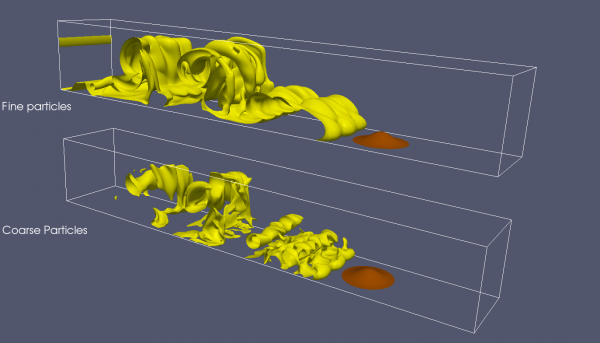HPCCprojects:Numerical simulations of turbidity and gravity currents interacting with complex topographies
Numerical simulations of turbidity and gravity currents interacting with complex topographies
Project description
Turbidity currents represent a large-scale geophysical flow phenomenon that plays an important role within the global sediment cycle, and in the formation of deep-sea hydrocarbon reservoirs (Meiburg and Kneller, 2010). Turbidity currents can be maintained for hours or even days, transport many km3 of sediment, and propagate over distances up to 1,000km. The sediment deposits generated by these currents, known as turbidites, extend over tens or even hundreds of kilometers along the bottom of the ocean, and they frequently are hundreds of meters deep. The interaction between turbidity currents and their deposits via erosion and deposition results in the formation of pronounced topographical features on the seafloor, such as channels, gullies, levees and sediment waves. Due to the infrequent and unpredictable occurrence of turbidity currents in remote areas, and their destructive nature, field data regarding their structure and evolution are very difficult to obtain. Consequently, in addition to laboratory experiments, high-resolution simulations have become an important tool for the exploration of their dynamics. These simulations are typically based on an augmented form of the Navier-Stokes equations. Ideally, they should be fully three-dimensional, incorporate erosion as well as deposition, respond dynamically to pre-existing and evolving sediment bed topography, and explicitly describe the thickness and grain-size distribution of the resulting deposits. The computational effort required for turbidity current simulations is largely a function of the Reynolds number Re = UH/nu, where U represents the front speed, H is a measure of the current height, and nu denotes the kinematic viscosity of the fluid, usually water. Direct Navier-Stokes simulations typically can reach Reynolds numbers of O(103 - 104), which makes it impossible to simulate geophysical turbidity currents in the ocean, which can reach Re = O(109). These orders of magnitude make clear the need for large-scale, massively parallel simulations, combined with accurate turbulence modeling efforts.
The present investigation describes the development and validation of a computational code called TURBINS (TURBidity currents via Immersed boundary Navier-Stokes simulations), which addresses many of the above needs. TURBINS, a highly parallel code written in C, is capable of modeling gravity and turbidity currents interacting with complex topographies in two and three dimensions. Accurate treatment of the complex geometry, implementation of an efficient and scalable parallel solver, i.e. multigrid solver via PETSc and HYPRE to solve the pressure Poisson equation, and parallel IO are some of the features of TURBINS.
TURBINS enables us to tackle problems involving the interaction of turbidity currents with complex topographies. It provides us with a numerical tool for quantifying the flow field properties and sedimentation processes, e.g. energy transfer, dissipation, and wall shear stress, which are difficult to obtain even at laboratory scales. By benefiting from massively parallel simulations, we hope to understand the underlying physics and processes related to the formation and deposition of particles due to the occurrence of turbidity currents.
Objectives
- Using numerical simulations to study/predict sediment transport resulting from turbidity currents
- Understanding the influence of the seafloor topographies on the fluid motion and sediment transport
Time-line
Start: Spring 2007
Models in use
TURBINS, which has the following features:
- Highly parallel code: MPI-based communication with domain decomposition parallelism
- Navier-Stokes equations: to describe the fluid motion
- Transport equation(s): to describe the particle (and/or salinity) motion
- Immersed boundary method: to enforce accurate boundary conditions at the solid surface
- Multigrid solver is implemented via PETSc and HYPRE packages to solve for the descretized pressure Poisson equation
- Turbulence modeling: LES/RANS (under development)
Results

- One snapshot of a DNS simulation conducted by TURBINS. Isosurface of particle concentrations (c=0.1) for a bidisperse turbidity current produced by a lock-exchange configuration interacting with a Gaussian bump. Reynolds and Schmidt numbers are equal to 2,000 and 1.0, respectively.
Users
Funding
Publications and presentations
E. Meiburg and B. Kneller, Turbidity currents and their deposits, Ann. Rev. Fluid Mech. 42, 135-156 (2010), doi:10.1146/annurev-fluid-121108-145618
M.M. Nasr-Azadani and E. Meiburg, TURBINS: An immersed boundary, Navier–Stokes code for the simulation of gravity and turbidity currents interacting with complex topographies, Computers & Fluids 45, 14-28 (2011), doi:10.1016/j.compfluid.2010.11.023
Links
Provide links related to your project.
